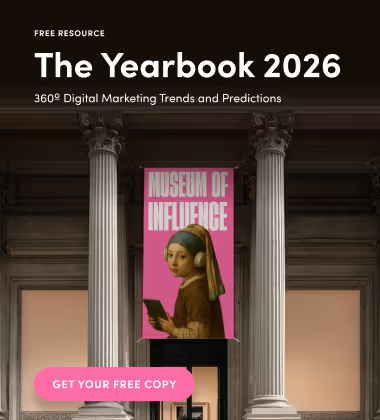Learn how 15 powerful ChatGPT prompts designed to craft high-converting CTA examples can help you in your next marketing campaign. From ChatGPT call-to-action examples to best practices, this guide gives practical prompts to boost your SEO and conversion rates.
Creating effective calls to action (CTAs) is important for driving conversions, interactions on social media platforms, and improving SEO performance. Crafting the perfect CTA can be time-consuming, but that’s where ChatGPT prompts are handy.
AI can give you creative ways to write compelling CTAs that resonate with your audience. In this post, you’ll find 15 actionable ChatGPT prompts for copywriting, including call-to-action examples and best practices, designed to boost your click-through rates and engagement.
Why CTAs Matter in SEO and Content Marketing
First things first: what is a CTA? A CTA stands for call to action, a prompt that encourages your audience to take a specific action, like making a purchase, signing up for a newsletter, or simply learning more about a topic. In simple terms, it’s the next step you want your visitor to take.
When looking at CTA language, CTAs come in two main types:
- Hard CTAs include action words like “Buy Now” or “Subscribe” and others that use urgency tactics.
- Soft CTAs are terms such as “Learn More” or “Download Guide” that direct users to engage on their terms.
From a user experience (UX) perspective, well-placed CTAs guide visitors through your content and reduce confusion. Strategically positioned CTAs on blog posts, landing pages, social media posts, or emails help lower bounce rates. They encourage users to stay longer and explore more of what you have to offer by taking an intended action.
For SEO, increased engagement signals search engines that your content is valuable and relevant, potentially boosting your rankings.
Effective CTA placements can lead to higher conversion rates by making the desired action clear and easy. Whether it’s a call-to-action button at the end of a blog or a prompt within an email, CTAs are great tools for turning potential customers into active customers.
Landing page CTAs alone can increase web page conversions by up to 79 %, and strategic CTA optimization can improve rates by 111 to 306 %. These points highlight the role a well-designed CTA plays in driving performance.
Here’s a quick breakdown:
15 ChatGPT Prompts to Write Impactful CTAs
Blog Post CTA Prompts
These prompts create compelling end-of-blog CTAs that not only increase engagement but reduce bounce rates by encouraging readers to explore more of your content elsewhere on your site.
Usually placed at the end of informational blogs, they’re designed to guide readers toward related blog posts or offer a valuable lead magnet like an ebook or checklist. By using clear and relevant CTAs, you keep your audience on your site longer, improving both user experience and SEO performance.
Try these prompts to craft effective blog post CTAs:
- Suggest three CTA variations for a blog post on [topic] targeting informational intent.
- Write three end-of-post CTAs that encourage readers to join a newsletter or download a free guide, based on a blog about [topic].
These prompts will help generate a range of options to test and optimize for maximum impact.
Landing Page CTA Prompts
Your landing page CTA is often the final nudge that converts a visitor into a customer. It needs to be clear, persuasive, and aligned perfectly with your value proposition to motivate action.
These prompts can help you craft high-impact CTAs for product, service, or sales pages that directly address your audience’s needs and pain points. By focusing on what matters most to your visitors, like saving time, cutting costs, or gaining exclusive benefits, you can create buttons and phrases that inspire trust and urgency.
Try these prompts to generate compelling landing page CTAs:
- Write five CTA buttons that highlight [value prop] and [audience need].
- Give three variations of a strong call to action for a landing page selling [product/service] to [audience type] focused on [key benefit].
These prompts are designed to help you test various messages, identify the most effective ones for converting visitors into customers, and discover the best fit for your target audience’s needs.
Email CTA Prompts
CTA in email marketing can be placed in the body of your email or tucked into the footer, but it needs to be personal, persuasive, and crystal clear. The right CTA can significantly improve click-through rates, guide subscribers toward specific products, and even turn one-time buyers into loyal customers.
These ChatGPT prompts can help you write natural and compelling email CTAs perfect for newsletters, promotional blasts, or post-purchase flows. If you’re looking to showcase a new product, encourage repeat purchases, or spark referrals, a well-crafted CTA helps move your audience one step closer to conversion.
Try these prompts to write stronger email CTAs:
- Write three CTAs that drive clicks to a product page from a newsletter.
- Create three CTA lines for a post-purchase email that encourage users to explore related products or refer a friend.
These prompts are an excellent starting point for engaging emails across various stages of the purchase funnel.

Image source: Shutterstock
Social Media CTA Prompts
Crafting the best CTAs for social media requires a sharp, concise approach that matches the pace of today’s scroll-heavy platforms. When you're creating content for Instagram Reels, TikToks, or even LinkedIn, your call to action needs to grab attention within seconds.
Strong social CTAs prompt users to click, comment, share, and save, which signal engagement to algorithms and help expand your reach. The prompts below are designed to help you write CTAs that drive interaction while staying authentic to your brand voice.
Try these prompts:
- Create three CTAs for a carousel post that encourages comments.
- Write three short CTAs for a Reel or TikTok promoting [product/service] that drive profile visits or link clicks.
From encouraging comments to gaining profile visits through short-form video, these CTA ideas are built for maximum engagement.
High-Converting CTA Button Copy Prompts
The button copy may be small, but it often carries the weight of the final decision. In today's complex digital landscape, a generic “Click Here” no longer cuts it. To boost conversions, your buttons should create urgency, deliver clear value, and feel like a natural next step in the user’s journey.
Whether you’re looking to lead someone to sign up, make a purchase, or explore a service, every word counts. We’ve listed a few prompts you can use to generate high-performing button CTAs that stand out and inspire immediate action.
From highlighting benefits to tapping into emotion or scarcity, great button copy can significantly lift your conversion rates and make it easy to measure CTA engagement.
Try these prompts for your button creations:
- Generate five button-style CTAs that avoid “Click Here” and create urgency.
- Write five concise, action-driven button texts for a [product/service] landing page focused on driving sign-ups or purchases.
✅By using these prompts, you’ll craft eye-catching buttons that look good but also work hard to drive results.
Personalization & CRO CTA Prompts
Personalized CTAs that respond to user behavior or segmentation improve conversion rates. Tailor your call to action to a visitor’s phase in their journey or past interactions, and you create a more relevant, engaging experience that encourages action.
These ChatGPT prompts help you generate CTAs designed for different user segments and behaviors. Try them and boost effectiveness on your landing pages, emails, and more.
- Write a CTA for returning users on a comparison landing page.
- Create three CTAs targeting first-time visitors, encouraging them to explore product benefits.
- Suggest three CTAs that appeal to cart abandoners, encouraging them to complete their purchase.
Using behavior-based CTAs ensures your messaging resonates with the user’s intent and context, increasing the likelihood of conversions and enhancing site performance.
CTA Copy Best Practices for SEO and UX
When done right, CTA copy enhances discoverability, guides users through your site, and contributes to overall content performance. To achieve that, follow the call-to-action best practices we’ve listed below:
Include Keywords
Including relevant, naturally integrated keywords in your CTA text helps search engines better understand your page’s purpose. This improves visibility for targeted queries, ranking your site higher.
Instead of writing a vague “Click Here,” try something more specific, like “Explore Budget-Friendly SEO Strategies” or “Download Our Free Social Media Planning Guide.”
Link Internally
Well-crafted CTAs often double as internal links, encouraging deeper engagement while strengthening your site’s SEO architecture. Linking to related blog posts, product pages, or service categories improves crawlability and distributes link equity throughout your site, ranking your site higher against competitors.
Match to User Intent
A CTA that aligns with what the visitor is trying to achieve is more likely to convert on your site. Users looking for information may respond best to soft CTAs like “Read the Full Guide” or “Discover How It Works,” while purchase-ready visitors may prefer direct CTAs like “Get Started Now” or “Buy Today.”
When your CTAs reflect keyword intent, support internal linking, and match audience expectations, you create a seamless experience that improves both rankings and results.

Image source: Canva
Turn CTAs Into Conversions
While ChatGPT prompts offer a powerful starting point for crafting compelling calls to action, they’re only one piece of the conversion puzzle. To truly maximize performance, you need to combine strong copy with testing, design, and strategic placement.
A/B testing your CTAs helps identify what language, tone, and structure resonate most with your audience. Even small changes, like switching a word or adjusting button color can significantly impact click-through and conversion rates.
However, testing alone isn’t enough; your CTA’s visual design, location on the page, and alignment with the surrounding content all influence how users respond.
Tailoring CTAs based on audience intent and behavior is equally important. A great CTA in the wrong context won’t convert. ChatGPT gives you options. Testing, design, and audience alignment make those options work.
Key Takeaways
- CTAs are essential for driving conversions, improving UX, and boosting SEO.
- ChatGPT prompts simplify and speed up CTA creation for blogs, emails, landing pages, and social media.
- There are two main types of CTAs:
- Hard CTAs (e.g., “Buy Now”) for direct action
- Soft CTAs (e.g., “Learn More”) for engagement
- Strategically placed CTAs reduce bounce rates and guide users through your site.
- Effective CTA copy and design can lift conversion rates by over 100%.
- CTA prompts can be customized for blogs, emails, landing pages, buttons, social media, and CRO.
- Personalized CTAs based on user behavior lead to higher engagement and conversions.
- Best practices for CTA copy include:
- Using relevant keywords
- Linking internally
- Matching CTAs to user intent
- Using relevant keywords
- A/B testing and design tweaks improve CTA performance by identifying what resonates with your audience.
- ChatGPT provides a great starting point, but human editing, placement strategy, and CRO are key to success.
Turn Insights Into Action With Smarter CTAs
Mapping your content to intent starts with a strong content strategy that aligns with user needs at every stage. Consistent, well-written posts, backed by professional blog writing, can help build authority and engagement over time.
And to turn that engagement into measurable action, conversion rate optimization (CRO) techniques like A/B testing and audience targeting play a key role in refining your CTAs and boosting results.
Need help scaling or optimizing CTA-driven content across your marketing channels? Let’s talk.



